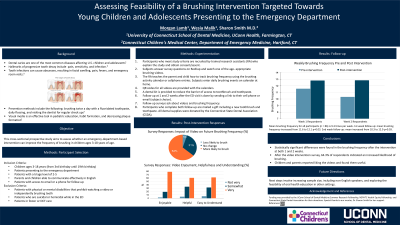Preventive
505 - Assessing Feasibility of a Brushing Intervention in Young Children and Adolescents Presenting to the Emergency Department


Morgan Lamb, BA (she/her/hers)
Dental Student
University of Connecticut School of Dental Medicine
University of Connecticut School of Dental Medicine
Farmington, Connecticut, United States- WM
Wesia Malik, B.S.
University of Connecticut School of Dental Medicine
- SS
Sharon Smith, MD
Professor of Pediatric Medicine
University of Connecticut School of Medicine
Hartford, Connecticut, United States - AT
Aditya Tadinada, D.D.S., M.Dent.Sci.
Associate Dean for Graduate Research, Education and Training
University of Connecticut School of Dental Medicine
Farmington, Connecticut, United States
Presenting Author(s)
Co-Author(s)
Research Mentor(s)
Program Director(s)
Purpose: Dental caries is prevalent among U.S. children. This study aims to assess the impact of an ED-based intervention on improving brushing frequency in children aged 3-18 years, promoting effective oral health practices.
Methods: Participants are recruited by research assistants who obtain consent. A tablet is used for surveys, including demographic info. Enrollment involves an educational video intervention, and collecting pre- and post-video oral health data. After ED enrollment, participants receive a dental kit with a toothbrush, toothpaste, brushing tracker/calendar, and instructions. Follow-up surveys at 1 and 2 weeks assess video satisfaction and brushing frequency. The primary outcome is the mean days children brush. Pre-intervention and post-intervention means are compared using a two-tailed t-test.
Results: Out of 90 approached patients, 86 were enrolled, with 56.6% female and 43.4% male participants. The average age was 9.3 years [SD = 4.6]. The majority were White (62.2%), followed by Black (24.4%), and other racial categories/mixed race (18.5%). Ethnicity breakdown: 38.6% Hispanic/Latino, 53.0% Not Hispanic/Latino, and 8.4% not reported. The mean brushing frequency for all (n = 86) was 9.3 times weekly. One-week follow-up (n=16) showed an increase from 11.6 to 12.8 (P=.03). Second-week follow-up (n=13) saw an increase from 10.3 to 12.9 (P=.04).
Conclusion: Statistically significant increases in brushing frequency were observed at 1 and 2 weeks. Respondents expressed a likelihood to brush more after watching the intervention video. This oral health intervention could be valuable in diverse settings, with potential for development in other languages.
Identify Supporting Agency and Grant Number: Research supported by the University of Connecticut School of Dental Medicine Summer Research Fellowship and NEPHTC Health Equity Fellowship.

.jpg)